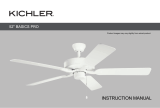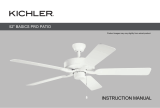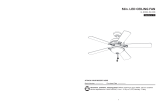
24 25
ETL-ES-Brentford-WH14 ETL-ES-Brentford-WH14
TROUBLESHOOTING GUIDE
If you have difficulty operating your new ceiling fan, it may be the result of incorrect assembly, installation, or wiring. In some
cases, these installation errors may be mistaken for defects. If you experience any faults, please check this Trouble Shooting
chart. If a problem cannot be remedied, please consult with your authorized electrician and do not attempt any electrical repairs
yourself.
1. If fan does not start: 1. check main and branch circuit fuses or circuit breakers.
2. check wire connections as performed in step #13 or #14 of installation.
CAUTION: Make sure main power is turned off.
3. Make sure forward/reverse switch is firmly in up or down position.
Fan will not operate when switch is in the middle.
4. If the fan still will not start, contact a qualified electrician.
Do not attempt to troubleshoot internal electrical connections yourself.
2. If fan sounds noisy: 1. check to make sure all screws in motor housing are snug (not over tightened).
2. check to make sure the screws which attach the fan blade holder to the motor are tight.
3. Some fan motors are sensitive to signals from Solid State variable speed controls.
DO NOT USe a Solid State variable speed control.
4. Allow “break-in” period of 24 hours. Most noises associated with a new fan will disappear
after this period.
3. If fan wobbles: All blades are weighed and grouped by weight. Natural woods vary in density which could
cause the fan to wobble even though all blades are weight-matched. The following
procedures should eliminate most of the wobble. check for wobble after each step.
1. check that all blades are screwed firmly into blade holders.
2. check that all blade holders are tightened securely to motor.
3. Make sure that canopy and mounting bracket are tightened securely to ceiling joist.
4. If blade wobble is still noticeable, interchanging two adjacent (side by side) blades can
redistribute the weight and possibly result in smoother operation.
4. If light does not work: 1. check to see that the wire connections in the switch housing are connected.
2. check for faulty light bulbs.
3. If light kit will still not operate, contact a qualified electrician for assistance.
NOTICE
This ‘energy Policy Act 2005’ compliant fan includes a device
that limits the total wattage of its light fixture to 190 watts.
By installing a combination of light bulbs that exceeds 190 watts or if an
electrical surge causes the wattage to exceed 190 watts, the light fixture
will either dim the lights to 190 watts or will automatically turn off.
To restore the light levels, make sure the total wattage of the light bulbs
does not exceed 190 watts and follow the applicable directions below:
For fans with Pull Chains:
Pull the light fixture’s pull chain two times to reset the light fixture.
If the power to your fan is controlled by a toggle wall switch, it may
be necessary to turn the power off and back on at the wall switch.
For fans with Wall Controls:
Press the light button on the wall control “off” and “on”
once to reset the light fixture.
For fans with Remote Controls:
If you verify the wattage and the lights do not turn on, press the
light button on the remote control twice to reset the light fixture.
NOTE: If the procedures above do not reset the lights,
turn off the main power source, located at the breaker panel or box,
and then turn it on again.
TROUBLE SUGGESTED REMEDY
GUÍA PARA SOLUCIONAR PROBLEMAS
Si tiene dificultades para hacer funcionar su nuevo ventilador, podría ser a causa del armado, instalación
o cableado incorrectos. en algunos casos, estos errores de instalación podrían ser confundidos con
defectos. Si experimenta alguna falla, consulte esta guía para solucionar problemas. Si no puede
solucionar el problema, consulte a un electricista autorizado y no intente reparar conexiones eléctricas.
1. Si el ventilador no arranca: 1. Compruebe los fusibles o disyuntores principales y del circuito derivado.
2. Compruebe el cableado del bloque de terminales como lo hizo en el paso No. 13 ó 14 de la
instalación. ADVERTENCIA: Asegúrese de que la alimentación principal esté apagada.
3. Asegúrese de que el interruptor de marcha adelante/atrás esté firmemente en su posición.
el ventilador no funcionará si el interruptor está en el medio.
4. Si el ventilador no arranca, póngase en contacto con un electricista calificado. No intente
reparar conexiones eléctricas internas.
2. Si el ventilador es ruidoso: 1. Compruebe para asegurarse de que todos los tornillos del alojamiento del motor estén
ajustados (no los apriete demasiado).
2. Compruebe para asegurarse de que los tornillos que fijan el soporte de la paleta del
ventilador al motor estén apretados.
3. NO USE un control de velocidad variable de estado sólido.
4. Permita el "rodaje" del ventilador durante un período de 24 horas. La mayoría de los ruidos
asociados con el ventilador nuevo desaparecerán después de este período.
3. Si el ventilador oscila: Todas las paletas se pesan y agrupan según el peso. Las maderas naturales varían en densidad
y podrían hacer que el ventilador oscile aún cuando todas las paletas estén agrupadas por
peso. Los siguientes procedimientos deberían eliminar la mayoría de los problemas de
oscilación. Verifique la oscilación después de cada paso.
1. Verifique que todas las paletas estén firmemente atornilladas a los soportes de las paletas.
2. Verifique que todos los soportes de las paletas estén firmemente aseguradas al motor.
3. Asegúrese de que el dosel y el soporte de montaje estén firmemente asegurados a la viga
del cielorraso.
4. Si la oscilación de la paleta sigue siendo visible, es posible que al intercambiar dos paletas
adyacentes (lado a lado) se redistribuya el peso y el funcionamiento sea más suave.
4. Si la luz no funciona: 1. Verifique que el conector molex del alojamiento del interruptor esté conectado.
2. compruebe si hay lámparas defectuosas.
3. Si el conjunto de luces no funciona, póngase en contacto con un electricista calificado.
PROBLEMA SOLUCIÓN SUGERIDA
AVISO
Este ventilador, que cumple con las exigencias del 'energy Policy Act 2005
incluye un accesorio que limita el vataje total de su lámpara a 190 vatio
Si usted instala una combinación de bombillas que sobrepasen
los 190 vatios o si un sobrevoltaje hace que el voltaje sea superior
a 190 vatios, la lámpara regulará la intensidad a 190 vatios o se apagar
Para restablecer el nivel de luminosidad, asegúrese que el vataje total
de las bombillas no sobrepase los 190 vatios y siga las indicaciones
Aplicables a continuación:
Para ventiladores con Cadenilla de tiro:
Jale la cadenilla de la lámpara dos veces para reiniciarla. Si la energía
de su ventilador se controla con un interruptor en la pared,
puede ser necesario apagar el interruptor y luego encenderlo.
Para ventiladores con Control de pared:
Presione el botón en la pared una vez para apagar y una vez
para encender, para así reiniciar la lámpara.
Para ventiladores con Control remoto:
Si verifica el vataje y la luz no enciende, presione el botón para
la luz en el control remoto dos veces para reiniciar la lámpara.
NOTA: Si los procedimientos mencionados no reinician la lámpara,
desconecte la fuente principal de energía, ubicada
en el panel o caja de interruptor, y vuélvala a conectar.















